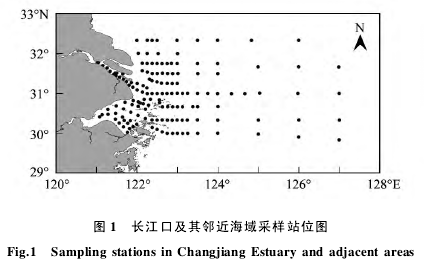摘要: 根据 2006-2007 年长江口及其邻近海域( 29°30'N-32°30'N,120°00'E-127°30'E) 150 个站位 4 个季节的调查资料,对长江口海域浮游动物群落结构、种类组成、优势种及其季节变化进行研究。结果表明,长江口及其邻近海域浮游动物群落物种多样性丰富,四季共鉴定浮游动物 460 种,隶属 7 个门,246 属,此外,另有 54 类浮游幼体。其中,桡足类是最优势类群,有 193种,占 41.96%; 端足类为第二优势类群,有 51 种,占 11.09%; 水螅水母为第三优势类群,有 34 种,占 7.39%.长江口及其邻近海域浮游动物的物种多样性呈现明显季节变化,其特征为: 夏季( 317 种) >秋季( 309 种) >春季( 230 种) >冬季( 138 种) .中华哲水蚤和百陶带箭虫为长江口及其邻近海域的四季优势种。长江口及其邻近海域浮游动物大体可划分为 5 种生态类群: 近岸低盐类群、广温广盐类群、低温高盐类群、高温广盐类群和高温高盐类群。结合同步调查的水文和水化学数据,进行浮游动物群落丰度与环境因子的相关分析表明: 盐度是影响长江口及其邻近海域的浮游动物群落丰度的主要环境因子。
关键词: 长江口; 浮游动物; 群落结构; 优势种; 季节变化。
Abstract: Seasonal variation of zooplankton community structure, species composition, and dominant species weredetermined based on samples collected from 150 stations during four research cruises in the Changjiang Estuary and itsadjacent waters ( 29° 30' N-32° 30' N,120° 00' E-127° 30' E ) . The study was conducted from July to August 2006( Summer) ,December 2006 to February 2007 ( Winter) ,April to May 2007 ( Spring) ,and October to December 2007( Autumn) . The mesoscale study areas were positioned from the Changjiang Estuary to the transition area where freshwaterfrom the Changjiang plume and offshore water masses,such as the Kuroshio and its branches,mix with each other. In total,460 species of zooplankton belonging to 246 genera and 18 groups from seven phyla,together with 54 types of pelagiclarvae,were identified in the Changjiang Estuary and its adjacent waters during four seasons. The 18 groups of zooplanktonincluded Hydromedusae,Siphonophora,Scyphomedusae,Ctenophora,Polychaeta,Cladocera,Copepoda,Ostracoda,Isopoda,Mysida, Cumacea, Amphipoda, Euphausiacea, Decapoda, Chaetognatha, Appendicularia, Thaliacea, andpelagic Mollusca. The most dominant group of zooplankton was Copepoda,including 193 species and accounting for 41.96%of the total species. Amphipoda ranked second,with 51 species accounting for 11.09% of the total species. Hydromedusawas the third dominant group of zooplankton with 34 species and accounted for 7. 39% of the total species. There wasconsiderable seasonal and spatial variation in the community structure of zooplankton in the Changjiang Estuary and itsadjacent waters. More zooplankton species were found in summer ( 317 species and 43 types of pelagic larvae) and autumn( 309 species and 28 types of pelagic larvae) than in spring ( 230 species and 27 types of pelagic larvae) and winter ( 138species and 21 types of pelagic larvae) . The number of species increased gradually from the inshore to offshore waters andfrom north to south,during all seasons. There were seasonal changes in dominant species in the Changjiang Estuary and itsadjacent waters: in spring and winter,Calanus sinicus was the most dominant species,but in summer and autumn,the mostdominant species was replaced by Centropages dorsispinatus and Subeucalanus subcrassus,respectively. Only Calanus sinicusand Zonosagitta bedoti were dominant in all four seasons. Based on species composition and ecological distribution,thezooplankton community in the Changjiang Estuary and its adjacent waters could be divided into five ecological groups,including the coastal brackish water,eurythermal euryhaline,hypothermal hypersaline,hyperthermal euryhaline,andhyperthermal hypersaline group. The dominant species were distributed primarily in the coastal brackish water group andeurythermal euryhaline group. Furthermore,we measured environmental factors and determined the responses of thezooplankton community to the factors, including temperature, salinity, concentration of suspended matter, andconcentration of chlorophyll a. Results of Pearson's correlation analysis revealed that the most important environmental factorinfluencing changes in zooplankton community structure in the Changjiang Estuary and its adjacent waters was salinity.
Furthermore,the Changjiang diluted water introduced a large number of nutrients,which was beneficial to the growth ofplankton,but the estuarine turbidity limited the distribution of zooplankton.
Key Words: Changjiang Estuary; zooplankton; community structure; dominant species; seasonal variation.
在典型的温带和亚热带地区,浮游动物是河口和近海生态系统的重要组成部分。浮游动物通过摄食浮游植物而影响初级生产,同时,又被更高营养阶层的动物( 鱼、虾、鲸、海鸟等) 捕食,其群落结构、种群动态和多样性影响许多鱼类和其他海洋动物资源的生物量,因而浮游动物在海洋食物网中起关键作用[1-2].同时,河口和冲淡水扩散区常受到陆架水系物理和化学特征的调控,这些复杂因素又影响着浮游动物群落结构及其分布[3].长江是我国最大的河流,水量丰沛,其平均年入海径流量约 9.28×1011m3,占输入东海总径流量的84.4%.长江冲淡水有明显的季节变化,5-10 月份为丰水期,占全年的 71.7%,11-4 月份为枯水期,占全年的 28.3%.在长江河口河水与海水经常交汇、径流与潮流相互抗衡的地带发育成最大浑浊带,最大浑浊带对河口泥沙的聚集和沉降起着十分重要的作用[4].长江口及邻近海域主要受长江冲淡水、台湾暖流、浙江近岸流和黄海冷水团等水系共同影响,水文环境复杂多变,浮游动物群落在不同水域存在明显差异。
从 1980 年以来,对长江口及其邻近海域浮游动物的研究已有不少报道[5-13],但是中尺度调查研究相对匮乏。首先,研究海域的范围主要集中在 124°E 以西近岸河口区或东海区海域,迄今缺少从长江内河段( 120°E) 开始延伸至长江冲淡水扩散海域( 127°E) 中尺度海域的研究报道。其次,针对长江口及其邻近海域浮游动物群落的类群组成及四个季节变化的系统报道甚少。本文采用经典的形态学分类方法,结合同步观测的其他环境因子调查结果,对长江口及其邻近海域( 包括长江内河段及长江冲淡水扩散海域) 浮游动物群落结构及季节变化等方面进行研究,旨在揭示长江口及其邻近海域浮游动物群落结构时空变化特征,并且探讨浮游动物群落的季节变动与环境因子的关系,为长江口海域资源的可持续利用和海洋生态系统研究提供基础资料和科学依据。
1 材料和方法。
1.1 调查区域、采样及分析方法。
2006-2007 年,在长江口及其邻近海域 29° 30' N-32° 30' N,120° 00' E-127° 30' E ( 图 1 ) 开展春季( 2007 年4 月-5 月) 、夏季( 2006 年 7 月-8 月) 、秋季( 2007 年10 月-12 月) 和冬季( 2006 年12 月-2007 年2 月) 4 个航次的海洋生物生态调查。海上调查由“中国海监 49 船”执行,调查海域共布设 150 个观测站( 图 1) .






